Dionne Sparks: Diaspora Conversations
Posted on: 15 October 2021 by Dionne Sparks (Artist) in 2021
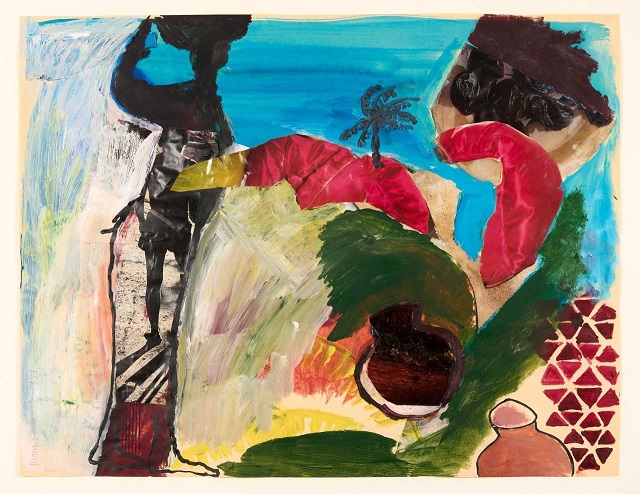
Artist Dionne Sparks revisits her collage-based work on paper, Conversations, acquired for the University of Liverpool’s collection in 1990 and traces the trajectory of her work from then to her current practice. Learn about the artist and what inspired her work over the years.
Diaspora Conversations: Then and Now
In this blog I look back at the piece, Conversations, that Liverpool University acquired over thirty years ago and trace the trajectory to my current practice. The title, Conversations, is a reference to the personal and political discourses of the African Diaspora. It was made shortly after a transformative visit to Nigeria, where I spent some weeks travelling and visiting Nigerian artists in their studios and homes. The motifs of sky, earth, tree, pot, cloth, pattern and the walking figure are still relevant in my practice today, though the formal language has transformed and their symbolic value has become more layered. The paint and collage veer on abstraction, anticipating that shift in my language.
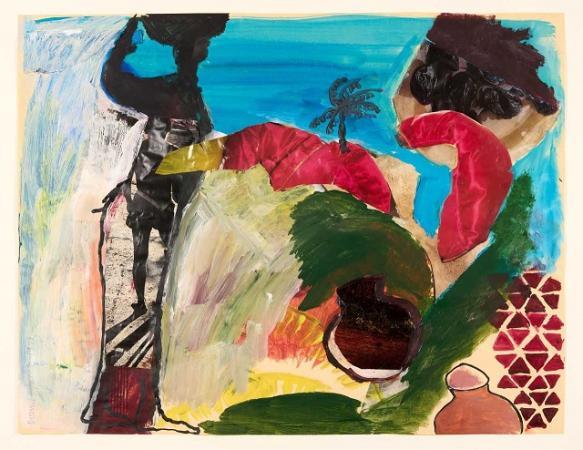
Conversations, acrylic and collage on paper, 1990
On my return to Liverpool in 1990, I recalled the kaleidoscopic images etched in my memory and explored my relationship with the African continent. Alice Walker’s poetry collection, Once, in which she recollects her visit to East Africa, was a touchstone in this process. This small water colour study, made in the same year as Conversations, is painted from a vivid memory of seeing cloth drying on the trees around water, where women had washed them and laid them out to dry. They seemed to fly like kites, spectacular dreams. They spoke of life, love, labour, intimacy, community, and toil. Cloth has always been laden with meaning for me.
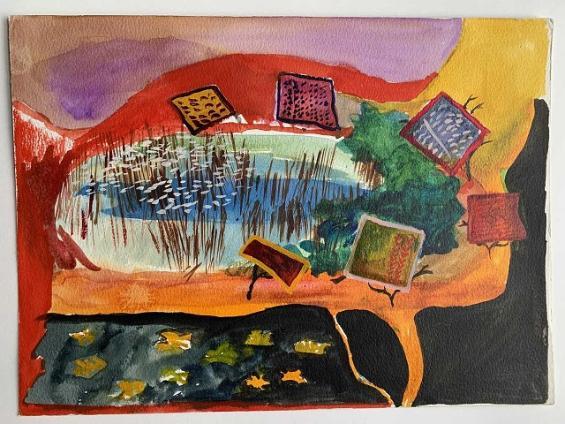
Study of Washing at the Water, watercolour on paper, 1990
Artistic journey
Following this period I spent some years in Berlin, where I continued to make use of painting and collage to explore my relationship to the history of Western Europe, and then returned to London in 1999. Around 2011 my work shifted from figuration to abstraction as I sought a more oblique language to engage the network of emerging ideas, where the identity politics of the 1980s and 90s became disrupted and more layered. My painting came to explore process driven abstraction underpinned by more philosophical concerns and inspired by Buddhist thought. Themes include repetition, pattern and the grid. I am interested in painting that engages the materiality of paint and other materials where meaning and form are fused.
I’ve worked as a teacher since 2002. To keep my practice alive, I seek ways to create work that fits my everyday life. Looking through sketchbooks from recent years, I see drawings of lines, grids, dots, looping lines, patterns, and forms of automatic drawing. Amongst these are littered notes, quotes and questions from my reading and listening. Drawing is a constant. I appreciate how Roni Horn describes drawing as a dialectic. Drawing and writing are thinking tools. They act as an inner conversation, tap into preoccupations, make connections, and map out networks of meaning, as in this double sided drawing on notation paper.
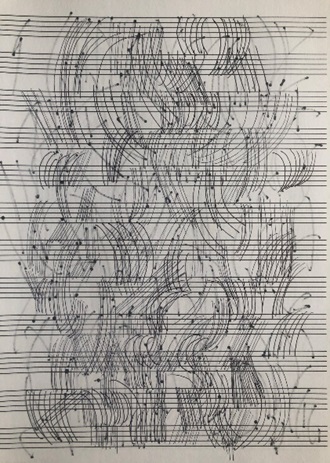
Sketchbook Drawing, pen on notation paper, 2021
Summer 2015
The summer of 2015 was pivotal, when I spent a week on a painting school at Falmouth University. The space and time allowed me to deepen my practice from the fragmented sketchbook notes into a more sustained focus. Not having a studio in London, the summer school gave me the confidence to create in the spaces of everyday life: at home where I live with my family, in the car, on my commute, while walking and in the classroom where I teach. I create a constant trickle of activity, until some level of clarity emerges. I photograph my immediate environment, the sky, the ground and draw on everyday life. I notice on reflection how these motifs persist and refer to Conversations. The formal concerns are informed by circumstance, which bend to and reflect conceptual preoccupations. An example of work to emerge from this process is, Way In, 2020.
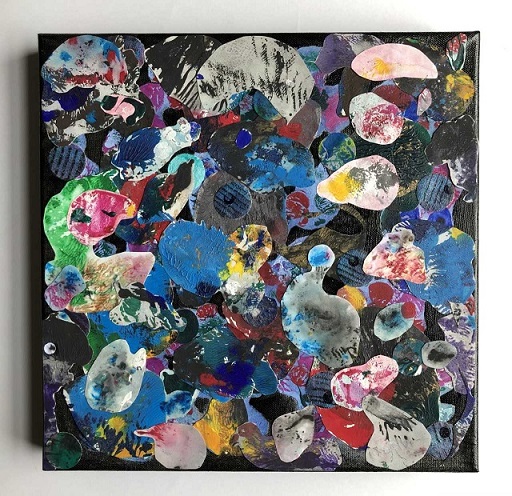
Way In, paper, acrylic and household paint on linen, 2020
Here you can see I accumulate materials over time. The paper is blotted from my students’ left over paint palettes and then cut into shapes suggested by these blots. I cut up grid like paintings into circles which punctuate the piece. Combining these materials, I explore transformation, layering a palimpsest of experience. In this small piece I experiment with bringing everything together and negotiating the discomfort of the groundless nature of living and the human tendency to want to order and control this rich and unstable experience. Conversations has something of the unstable and the suggestion that potentiality can be sort in the pot, the planted seed.
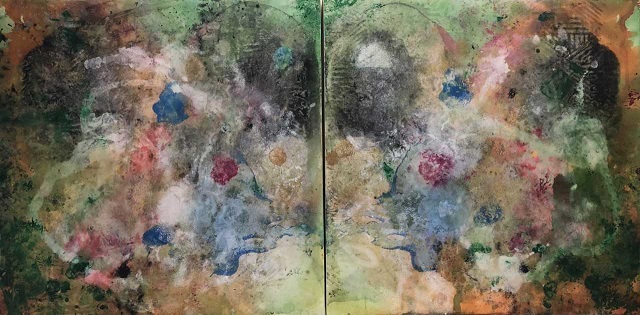
Bloom 3, acrylic and ink on canvas, 2018
This diptych, Bloom 3, 2018 is created as part of a series exploring repetition. Each piece is poured, dripped, blotted, and washed. The process is rapid, retaining the spontaneous quality of the mark making as the painting is coaxed into being. Each canvas loosely mirrors the other and the layers of marks suggest an image coming into bloom. They appear to echo parts of the body and are like the brain wiring together, suggesting a mind-body connection. Looking back at Conversations, I see an echo of the motifs such as the sky, earth and water acting as a mirror of possibility. The cloth is also here, though more abstracted, appearing as an imprint in the surface (a reference to the Buddhist ideas of imprints which exist in the mind).
Engagement with abstraction
Pivotal shows which informed my engagement with abstraction include: ‘Agnes Martin’, Tate Britain, 2015; ‘Soul of a Nation’, Tate Modern, 2017; 'More Dimensions Than You Know, Jack Whitten, 1979 – 1989', Hauser and Wirth, 2017; Julie Mehretu, ‘Sextant’ White Cube, 2018; ‘Cerberus’, Mark Bradford, Hauser and Wirth, 2019 and ‘Frank Bowling’, Tate Britain, 2019. Artists such as these encourage me in the conversation with retrained and gestural language, where Black and women artists push the boundaries of abstraction in a complex world.
I’m not the kind of artist who works something out and then makes it, instead the making is the working out. It’s the way I ask questions and invite a conversation. I trust the intuitive process to make connections and create a meaningful narrative. Right now, I embark on a new journey as I begin the MA Painting at the RCA and anticipate the rich potential of the next conversation.
To find out more about Dionne Sparks
Dionne will be speaking as part of a panel discussion that will accompany the exhibition Maud Sulter: Centre of the Frame at Murray Edwards College, University of Cambridge on the 19th November. Please visit the website for further information or book tickets on Eventbrite.
Dionne is currently studying MA Painting at the RCA and is a recipient of The Basil H. Alkazzi Scholarship Award 2021. You can see more of Dionne’s work on her website and follow her on Instagram
Art Glossary
Figuration: representative art featuring figures and other identifiable forms
Abstraction: non representational art without identifiable figures or forms
Keywords: Dionne Sparks, African Diaspora, Art, Collage, Watercolour, Acrylic.